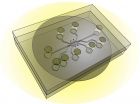(Press-News.org) The Tibetan Plateau in south-central Asia, because of its size, elevation and impact on climate, is one of the world's greatest geological oddities.
At about 960,000 square miles it covers slightly more land area than Alaska, Texas and California combined, and its elevation is on the same scale as Mount Rainier in the Cascade Range of Washington state. Because it rises so high into the atmosphere, it helps bring monsoons over India and other nations to the south while the plateau itself remains generally arid.
For decades, geologists have debated when and how the plateau reached such lofty heights, some 14,000 feet above sea level, about half the elevation of the highest Himalayan peaks just south of the plateau.
But new research led by a University of Washington scientist appears to confirm an earlier improbable finding – at least one large area in southwest Tibet, the plateau's Zhada Basin, actually lost 3,000 to 5,000 feet of elevation sometime in the Pliocene epoch.
"This basin is really high right now but we think it was a kilometer or more higher just 3 million to 4 million years ago," said Katharine Huntington, a UW associate professor of Earth and space sciences and the lead author of a paper describing the research.
Co-authors are Joel Saylor of the University of Houston and Jay Quade and Adam Hudson, both of the University of Arizona. The paper was published online in August and will appear in a future print edition of the Geological Society of America Bulletin.
The Zhada Basin has rugged terrain, with exposed deposits of ancient lake and river sediments that make fossil shells of gastropods such as snails easily accessible, and determining their age is relatively straightforward. The researchers studied shells dating from millions of years ago and from a variety of aquatic environments. They also collected modern shell and water samples from a variety of environments for comparison.
The work confirms results of a previous study involving Saylor and Quade that examined the ratio of heavy isotope oxygen-18 to light isotope oxygen-16 in ancient snail shells from the Zhada Basin. They found the ratios were very low, which suggested the basin had a higher elevation in the past.
Oxygen-18 levels decrease in precipitation at higher elevations in comparison with oxygen-16, so shells formed in lakes and rivers that collect precipitation at higher elevations should have a lower heavy-to-light oxygen ratio. However, those lower ratios depend on a number of other factors, including temperature, evaporation and precipitation source, which made it difficult to say with certainty whether the low ratios found in the ancient snail shells meant a loss of elevation in the Zhada Basin.
So the scientists also employed a technique called clumped isotope thermometry, which Huntington has used and worked to refine for several years, to determine the temperature of shell growth and get an independent estimate of elevation change in the basin.
Bonding, or "clumping" together, of heavy carbon-13 and oxygen-18 isotopes in the carbonate of snail shells happens more readily at colder temperatures, and is measured using a tool called a mass spectrometer that provides data on the temperature of the lake or river water in which the snails lived.
The scientists found markedly greater "clumping," as well as lower ratios of oxygen-18 to oxygen-16 in the ancient shells, indicating the shells formed at temperatures as much as 11 degrees Celsius (20 F) colder than average temperatures today, the equivalent of as much as 5,000 feet of elevation loss.
Just why the elevation decline happened is open to speculation. One possibility is that as faults in the region spread, the Zhada Basin lowered, Huntington said. It is unknown yet whether other parts of the southern plateau also lowered at the same time, but if elevation loss was widespread it could be because of broader fault spreading. It also is possible the crust thickened and forced large rock formations even deeper into the Earth, where they heated until they reached a consistency at which they could ooze out from beneath the crust, like toothpaste squeezed from the tube.
She noted that climate records from deep-sea fossils indicate Earth was significantly warmer when the cold Zhada Basin snail shells were formed.
"Our findings are a conservative estimate," Huntington said. "No one can say this result is due to a colder climate, because if anything it should have been warmer."
INFORMATION:
Funding was provided in part by the National Science Foundation, the American Chemical Society Petroleum Research Fund, the Comer Foundation and the Natural Science Foundation of China.
For more information, contact Huntington at 206-543-1750 or kate1@uw.edu, or Saylor at 713-743-3399 or jesaylor@uh.edu.
Snail shells show high-rise plateau is much lower than it used to be
2014-09-22
ELSE PRESS RELEASES FROM THIS DATE:
Cheater, cheater: UGA study shows what happens when employees feel excluded at work
2014-09-22
Athens, Ga. – When employees feel left out, they act out.
That's the message that new research from the University of Georgia Terry College of Business delivers as it explains why employees can become weasels to benefit their work group.
"Everybody has a need for social approval. It's the basis of our human functioning," said Marie Mitchell, co-author of the research and professor of management at UGA. "But when individuals are faced with a risk of social exclusion, it motivates some pretty unsavory behaviors. We already know how people react when they're definitely ...
Reversing the effects of pulmonary fibrosis
2014-09-22
New Haven, Conn. – Yale University researchers are studying a potential new treatment that reverses the effects of pulmonary fibrosis, a respiratory disease in which scars develop in the lungs and severely hamper breathing.
The treatment uses a microRNA mimic, miR-29, which is delivered to lung tissue intravenously. In mouse models, miR-29 not only blocked pulmonary fibrosis, it reversed fibrosis after several days.
The findings were published Sept. 19 in the journal EMBO Molecular Medicine.
"The mimic, when injected into the blood, goes to the lung and it has a ...
Experts provide much-needed policy analysis for clinical integration of next generation sequencing
2014-09-22
HOUSTON – (Sept. 22, 2014) – As genetic sequencing technologies continue to evolve rapidly, becoming part of clinical care, there is a critical need to establish appropriate policies and regulatory frameworks to address potential challenges, legal and ethical experts have said. A special policy issue of the Journal of Law, Medicine & Ethics published online today and edited by experts with the Center for Medical Ethics and Health Policy at Baylor College of Medicine gives policy makers the tools to jumpstart this process.
Experts with the Center for Medical Ethics and ...
Can tapioca replace corn as the main source for starch sweeteners?
2014-09-22
New Rochelle, NY, September 22, 2014—Cassava, also known as tapioca, has large starch-filled roots and can grow at high yields in areas of Africa, Asia, and Latin America where corn and sugarcane are not commonly grown. With the availability of novel enzymes and processes designed to break down tapioca starch into sugars that can then be used to produce sweeteners such as glucose, fructose, or maltose syrup, tapioca may be an ideal alternative to corn, as described in a Review article in Industrial Biotechnology, a peer-reviewed journal from Mary Ann Liebert, Inc., publishers. ...
Kessler pilot study demonstrates benefits of wellness program for people with MS
2014-09-22
West Orange, NJ. September 22, 2014. Kessler researchers have published a pilot study showing the benefits of a 10-week psychoeducational wellness program in people with multiple sclerosis (MS). Improvements were seen in mood, overall mental health, perceived stress, and pain. "Development and effectiveness of a psychoeducational wellness group for individuals living with MS: Description and outcomes" was epublished ahead of print on September 3 in the International Journal of MS Care (doi: 10.7224/1537-2073.2013-045). The authors are Kimberly Beckwith McGuire, PhD, of ...
Priorities for research on pharmaceutical and personal care products in the environment
2014-09-22
PENSACOLA, Fla. – In 2011 the Society of Environmental Toxicology and Chemistry (SETAC) held a workshop for 45 international experts to identify and prioritize the scientific research needed to understand the risks of pharmaceuticals and personal care products (PPCPs) in the environment. The effort was extended, and results were published in the most recent issue of the Society's international journal, Integrated Environmental Assessment and Management (IEAM). The published work is accompanied by a podcast interviewing the lead author of the study, Murray Rudd from the ...
Wildfires in Khabarovsk Krai, Russia
2014-09-22
Most of the fires captured in this image burn in Khabarovsk Krai, a territory occupying the coastline of the Sea of Okhotsk. Dozens of red hotspots, accompanied by plumes of smoke mark active fires. The smoke, which appears mostly white or grey, blows to the east towards the Sea of Okhotsk. Taiga and tundra are found in the north of this area, swampy forest inhabit the central depression, and deciduous forests are the natural vegetation in the south.
While large wildfires are common in Russia in the summer, the 2014 wildfire season appears to be more intense than usual. ...
New chip promising for tumor-targeting research
2014-09-22
WEST LAFAYETTE, Ind. – Researchers have developed a chip capable of simulating a tumor's "microenvironment" and plan to use the new system to test the effectiveness of nanoparticles and drugs that target cancer.
The new system, called a tumor-microenvironment-on-chip (T-MOC) device, will allow researchers to study the complex environment surrounding tumors and the barriers that prevent the targeted delivery of therapeutic agents, said Bumsoo Han, a Purdue University associate professor of mechanical engineering.
Researchers are trying to perfect "targeted delivery" methods ...
Brainwave test could improve autism diagnosis and classification
2014-09-22
September 22, 2014 – (BRONX, NY) – A new study by researchers at Albert Einstein College of Medicine of Yeshiva University suggests that measuring how fast the brain responds to sights and sounds could help in objectively classifying people on the autism spectrum and may help diagnose the condition earlier. The paper was published today in the online edition of the Journal of Autism and Developmental Disabilities.
The U.S. Centers for Disease Control and Prevention estimates that 1 in 68 children has been identified with an autism spectrum disorder (ASD). The signs and ...
Common diabetes drug associated with risk of low levels of thyroid hormone
2014-09-22
Metformin, a commonly used drug for treating type 2 diabetes, is linked to an increased risk of low thyroid-stimulating hormone (TSH) levels in patients with underactive thyroids (hypothyroidism), according to a study in CMAJ (Canadian Medical Association Journal). Low levels of TSH can cause harm, such as cardiovascular conditions and fractures.
Metformin is used to lower blood glucose levels by reducing glucose production in the liver. However, some previous studies have raised concerns that metformin may lower thyroid-stimulating hormone levels.
Researchers looked ...





